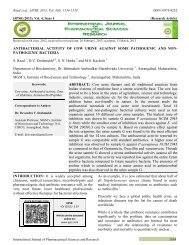fibonacci-numbers
fibonacci-numbers
fibonacci-numbers
You also want an ePaper? Increase the reach of your titles
YUMPU automatically turns print PDFs into web optimized ePapers that Google loves.
. Shifting the register down the Fibonacci number results into the conversion from kilometers<br />
to miles (Hazewinkel, 2002) (Knott, Using the Fibonacci <strong>numbers</strong> to represent whole <strong>numbers</strong>,<br />
2009).<br />
A close observation of our nature revels that Fibonacci <strong>numbers</strong> are often found in two<br />
consecutive Fibonacci <strong>numbers</strong> in biological setting (Douady & Couder, 1995), branching in<br />
trees, and arrangement of leaves on a stem, and the fruitlets of a pineapple (Jones & Wilson,<br />
2006) for example. The flowering of artichoke and arrangements of a pine cone is yet another<br />
example (Brousseau, 1969). The Fibonacci <strong>numbers</strong> have also been observed in the family tree<br />
of honeybees (Thimbleby). H. Vogel in<br />
1979 proposed a model for the pattern of<br />
florets found in the head of a sunflower<br />
(Vogel, 1979) as below:<br />
2 , √<br />
∅ Here, is the index number of the floret<br />
while is a constant scaling factor.<br />
Figure 3 Sunflower head displaying florets in spirals of 34 and 55<br />
around the outside<br />
Therefore, florets lie on Fermat's spiral. The divergence angle is approximately 137.51 ° which is<br />
known as the golden angle because this angle divides a circle in the golden ratio. The reason<br />
sunflower florets pack so efficiently is since this ratio is an irrational number; no floret has a<br />
neighbor at exactly the same angle from the center. The rational approximations to the golden<br />
ratio are of form : 1. For this reason, the nearest possible neighbor of floret number<br />
are those at for some index which is dependent of , the distance from the center.<br />
Fibonacci <strong>numbers</strong> Page 8









